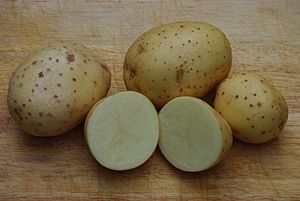Maris Piper facts for kids
Quick facts for kids Maris Piper |
|
|---|---|

Tubers of Maris Piper
|
|
| Genus | Solanum |
| Species | Solanum tuberosum |
| Cultivar | 'Maris Piper' |
| Breeder | H.W. Howard |
| Origin | Plant Breeding Institute, Trumpington, Cambridgeshire, Britain 1956 |
The Maris Piper is a very popular potato in the United Kingdom. It is the most widely grown potato variety there. In 2014, it made up 16% of all potato fields planted.
This potato was first introduced in 1966. It was one of the first potato types bred to be strong against a tiny worm. This worm, called a potato cyst nematode, is a big problem for potato farms in the UK. Maris Piper has been the most popular potato in the UK since 1980. It is great for many uses, like making chips, roast potatoes, and mashed potatoes.
Contents
How Maris Piper Potatoes Were Bred
Scientists started looking for ways to make potatoes stronger against a tiny worm called the potato cyst nematode in 1941. A scientist named Conrad Ellenby tested many different types of wild potatoes. He wanted to find ones that could fight off the worm.
By 1948, Ellenby found four types of wild potatoes that were strong against the worm. These could also be crossed with regular potatoes. One of these wild potatoes, called CPC 1673, helped make Maris Piper strong against the nematode. Even though this wild potato was resistant, it grew very small potatoes in the UK.
Creating a Stronger Potato
A team led by H. W. Howard worked at the Plant Breeding Institute in Cambridge. They crossed the wild potato (CPC 1673) with popular potato types. Their goal was to create a potato that grew a lot and could also fight off the worm.
The wild potato was crossed with other types like Ulster Knight and a mix of Arran Cairn and Herald. Arran Cairn was bred by Donald Mackelvie, a top Scottish potato breeder. Ulster Knight came from John Clarke, a famous breeder from Antrim.
The final cross was made in 1956. But it took ten more years for the potato to be fully tested and grown. In 1966, it was officially recommended by the National Institute of Agricultural Botany. The Plant Breeding Institute and H. W. Howard won the Queen's Award for Technology in 1982 for creating Maris Piper.
The Name Maris Piper
The first part of the name, "Maris," comes from Maris Lane in Trumpington. This is where the Plant Breeding Institute was located. The breeder, H. W. Howard, got to choose the second part of the name. His son picked "Piper" just because he liked it. Maris Piper should not be confused with Maris Peer, which is a different type of potato.
How Maris Piper Potatoes Are Used
Maris Piper became the most popular potato in the UK by 1980. In 1982, it made up 24% of all British potato crops. This dropped to 20% in 2005 and 16% in 2014. It became popular because it could fight off nematodes and tasted good to people.
Maris Piper potatoes have a fluffy texture. They are known as an "all-rounder" potato. This means they are good for many different dishes. They are often used to make chips (French fries). This is because they have a lot of dry matter and low sugar. Besides being sold fresh, Maris Piper potatoes are also used to make frozen or dried potato products.
Famous chefs like Heston Blumenthal and Tom Kerridge have recommended Maris Piper. They say it is great for making triple cooked chips. Heston Blumenthal even said they were "in a league of their own" for making roast potatoes. He also thinks they are the best for mashed potatoes.
Maris Piper Potato Traits
Maris Piper potatoes can be easily eaten by slugs. They are also very likely to get a disease called common scab. This disease causes rough, corky spots on the potato skin. To control common scab, farmers need to water the crops at just the right time. This happens when the potatoes are just starting to grow.
Maris Piper was one of the first potato types to be resistant to the G. rostochiensis nematode. It has a special gene called H1. This gene gives it full resistance to the types of nematodes found in the UK. Because Maris Piper was grown so much, another similar nematode, G. pallida, became the main problem in the UK. Maris Piper does not have resistance to this second type of nematode.
When nematodes try to feed on the roots of a Maris Piper potato, the H1 gene causes the potato roots to die. This stops the nematodes from feeding. It often causes them to die or turn into males, which cannot reproduce. The H1 gene is thought to make a protein that finds a specific part of the nematode. This is like a special lock-and-key system between the potato and the worm.
Images for kids




